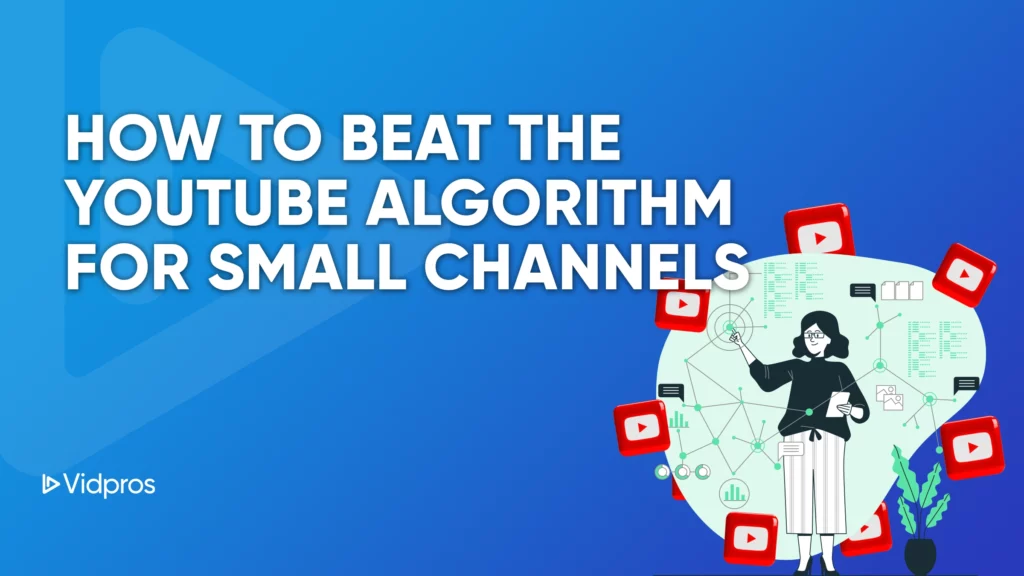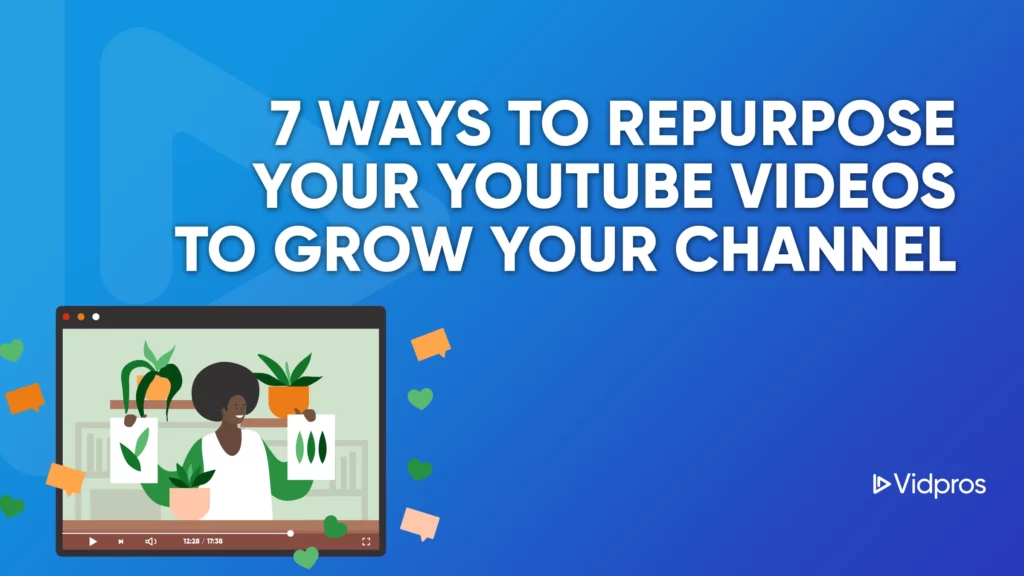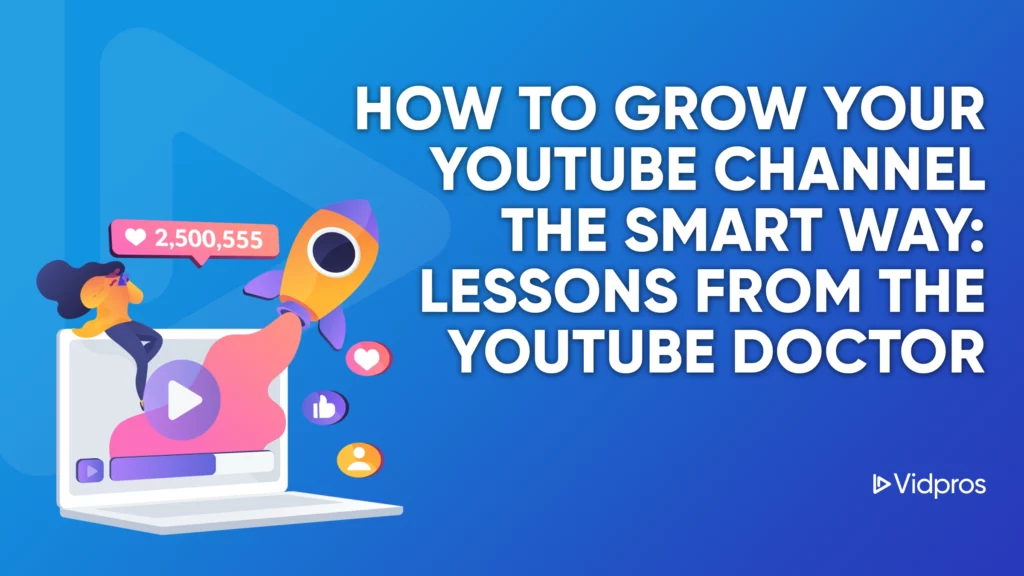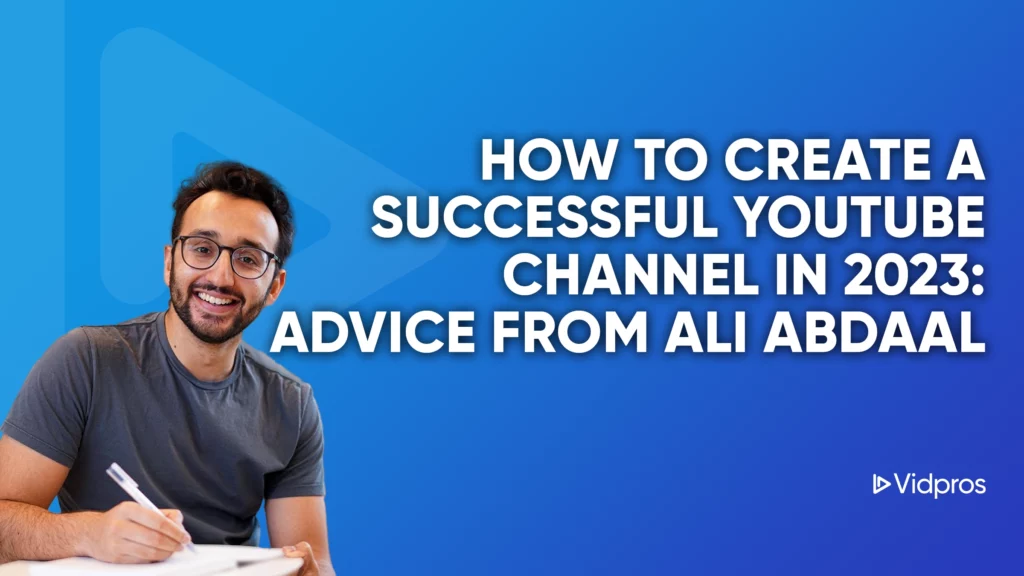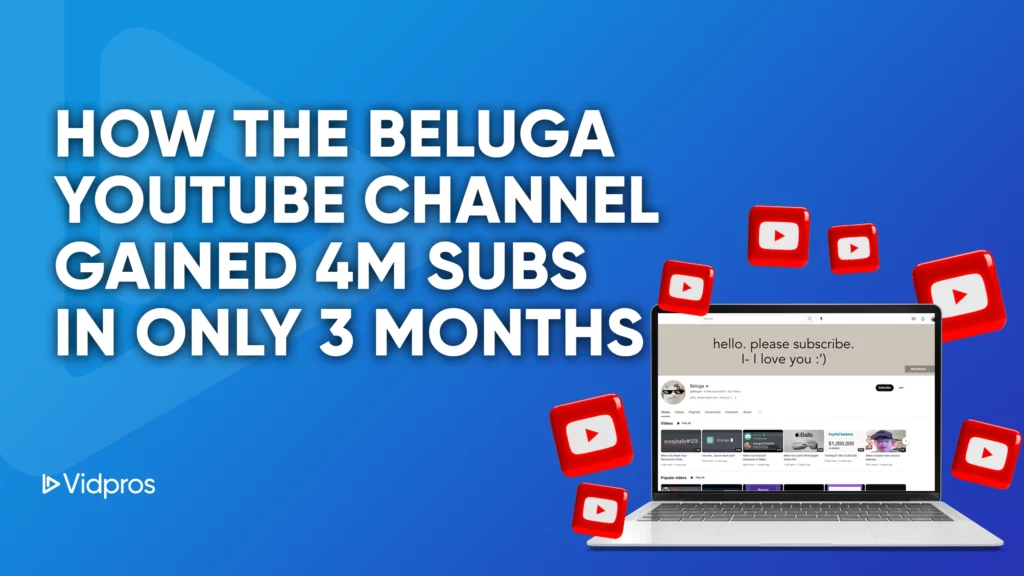Life can be tough on small channels. The big boys and girls have a huge advantage when it comes to putting out new content and getting that sweet algorithm boost. They already have an audience of YouTube users who will naturally watch their latest video.
But you don’t have the same luxury when you’re a new or small channel.
So does that mean you don’t have a chance? Not even close. In fact, one of the biggest benefits of being small is you can experiment and switch things up until you find a winning formula.
And this article today is aimed at helping you discover your winning formula so the algorithm puts you in its backpack and carries you to the promised land.
We’ve put together advice from Marcus Jones on how to beat the YouTube algorithm for small channels. Marcus is the creator behind Grow Your Gaming Channel. His channel focuses exclusively on helping YouTube creators launch and grow their channels. The majority of his uploads don’t even mention gaming.
He also runs a successful 90-day coaching program where he guarantees you’ll get your first 1000 subs in 90 days. So if you’re struggling to get views on your videos and it feels like YouTube’s algorithm is ignoring your channel, pay attention to Marcus’ tips. They show how he went from single-digit YouTube video views to now getting 500+ views served up every single hour.
When you’re a small channel, those views add up quickly and help your channel build momentum. Those extra views also lead to more subscribers and more income.
So let’s go through creating your winning formula step by step.
Be Clear About What Type Of Content You Create
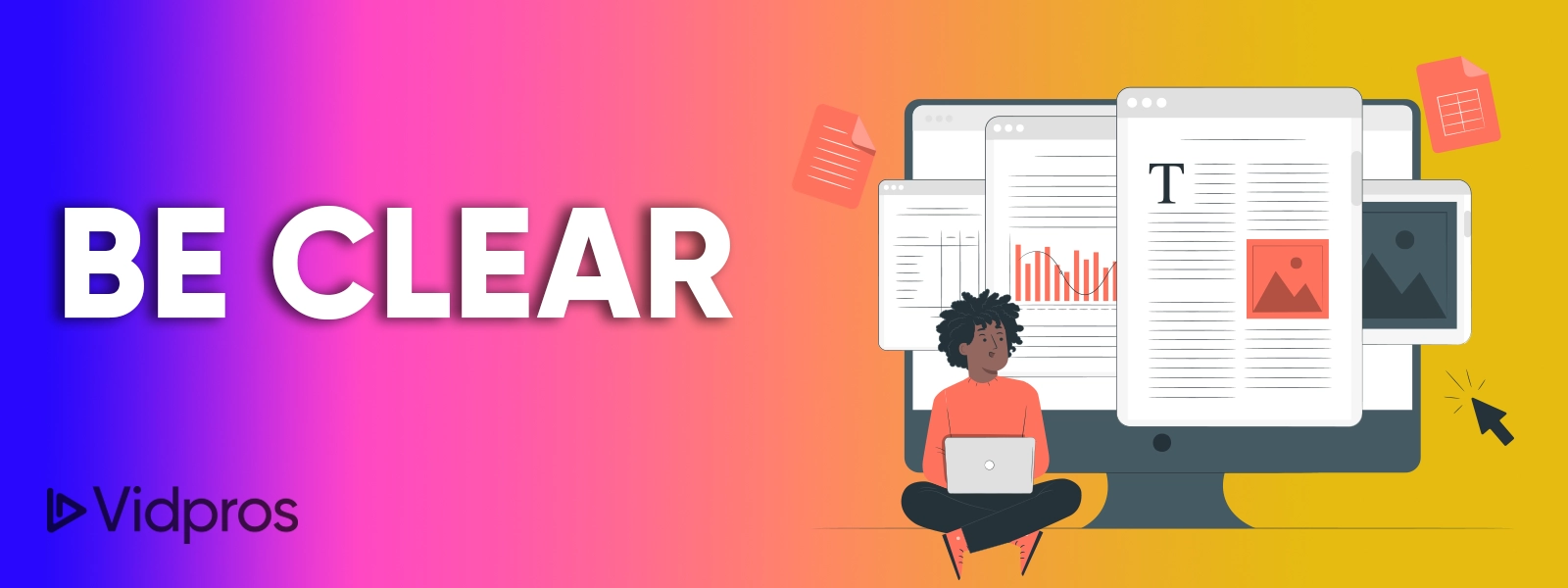
The first step might sound really obvious, but you’d be amazed how many small YouTubers who don’t get love from the algorithm skip over this topic, or they don’t do it properly.
See, many small channels hear the advice; you need to be consistent.
And so they take that information, say “okay”, and then post one video weekly for six months. And then assume their channel will hit this tipping point where the views just keep compounding and compounding, and eventually, their channel will blow up.
Focus On One Thing
![]()
But in reality, it doesn’t work that way because while being consistent in how often you upload helps, it’s not the only area of consistency for your channel. Consistency also applies to the actual content of your YouTube videos themselves.
So, for example, even if you post one video every week, you aren’t being consistent if you post bass fishing videos one week and the next week you post other videos on League of Legends tips and tricks. All of your channel’s content should appeal to the same YouTube audience. If you have content that doesn’t fit, put it on a new channel. You can create videos on as many topics as you want. Just keep them separate.
So get your niche down first. Once you do, that’s when you can really start to work some magic with this strategy.
If you want help thinking about your niche, you can check out our suggested articles at the end of this post. Check out the one on advice from Mr. Beast, but that’s for later…
The first thing Marcus wants to teach you is some Inception-level stuff. And we’ll talk about Marcus’ channel for reference.
The Only Thing You Really Need To Understand – How To Beat The YouTube Algorithm For Small Channels

So you want to take your niche. Which, for Marcus, is how to grow on YouTube. And you want to thoroughly research it. And I know research sounds super vague. So don’t worry; we will show you step by step what Marcus recommends in just a second.
So why are we talking about practicing research when this article is about hacking the algorithm?
Well, don’t take it from us. Take it from Mr. Beast’s conversation with Todd Beaupre (YouTube’s Director of Product Development) on how the YouTube algorithm works. And what’s their advice?
Anytime you say the word “algorithm”, replace it with “audience”.
So don’t say the algorithm didn’t like that video. No, the audience didn’t like that video.
So basically, when it seems like the algorithm is ignoring you, it’s actually that the viewers don’t really enjoy your content as much as you think they do. And the algorithm is just picking up on that.
The algorithms only job is to suggest the right video to the right viewer at the right time. So, if you make high-quality content your target audience enjoys, everything else will take care of itself. And you can let the YouTube algorithm work for you. It’s the most important part of the whole process.
Use Your Analytics – They Tell A Story

What should you do if a video isn’t performing well? The best place to start is to examine your data to learn why. So head on over to YouTube Studio and dive into your YouTube analytics.
If you look through your dashboard and find that one of your videos only had three views in several months, you could safely say that’s a pretty terrible result.
And then you might think that the algorithm is just ignoring this video, and it didn’t have a chance. Because all of your content rocks, right?
Well, if you look at your analytics, you can find out. If you check the analytics for that poor performer, you might see that it had 250 impressions but only 3 views for a 1.2% click-through rate. So the algorithm pushed this out to 250 people, but most didn’t click on the video.
And for those three people who did click on this video, they probably didn’t engage with it as enthusiastically as maybe they did with other similar competitive videos.
And so the algorithm stops promoting this video because it’s clearly not keeping people’s attention or satisfying them. So it decides to promote other videos instead.
All right, now that you have your niche set and understand the most important thing about the algorithm – it’s time to research your competition so you can learn and adapt.
Who Are Your Competitors?
![]()
The good news is…there are secrets and clues to what satisfies viewers in your niche and entices them to click on a suggested video. And they are hidden in plain sight in your competitor’s content.
And so, the first step in this entire process is to do the research in your niche and figure out who your competitors are.
And so here’s an example of how Marcus would do this for his channel. He would use YouTube search and type in terms highly related to the words people in his niche would look up.
So maybe something like “how to get views on YouTube.” And then, from there, he sees a ton of videos from other creators. And many of them are his direct competition.
And so, once you’ve found all your direct competitors for this particular search term, you can do it for your other key search terms. Next, he might search for “how to get subscribers.” And you can do this for your niche, find the popular keywords and look them up to find out who you’re competing against as the first step.
Subscribe To All Of Them
You should click on each of these channels and subscribe to them. That way, you have all your competitors subscribed in one place. You can track them and see more videos on trends and popularity in your niche.
And as a bonus, the algorithm often serves you content from new competitors – they’ll spring up in your YouTube homepage recommended videos. So mix up your watch history and consume a lot more content in your niche for an edge.
So you can find new competitors without having to search them out.
So when Marcus did this for his channel, he ended up with about 124 people he considered to be direct competitors in his niche – creating content to help grow YouTubers’ channels.
You might have a lot more than that. You might have a lot less than that. Either way, figure out who they are and start to track them in one place. You could also track them all in a spreadsheet if that makes you happy.
Track Monthly Views To See Who Is Winning

And so once you’ve done this, you want to sort through and find the top five to ten channels based on monthly views.
Don’t worry so much about sub count; you want to track how many views they actually get each month. Why? Well, it’s because often you’ll find there might be channels with huge amounts of subscribers that actually get beaten in views by small channels that put out better content.
And that’s what this whole plan is about for you. You can beat the big channels with the right approach.
Now, you can do this manually, obviously, but it is a bit of a pain. You can use the free account on sites like Social Blade and vidIQ and copy and paste the info into your spreadsheet. It will be time-consuming, and you’ll be limited in how many competitors you can track and how much info you can get. But you can start for free.
If you can afford it, Marcus uses and recommends vidIQ. It lets you follow and track your competitors and gain data-driven insights into their channels. And you want to track the top 10-20 competitors in your niche. If you can’t afford a paid tool, don’t let it stop you. Maybe adjust and only track the top 5 competitors to save time.
If you have vidIQ, use their comparison tool. You can set the date range to the past 30 days and filter based on views. And this gives a straightforward visual summary to see who’s getting most of your niche’s monthly views. And this is who you want to study and learn from.
So if you have the vidIQ extension installed, go to a competitor’s channel, and you’ll see a small button called “CSV Export.”
Get The Data Into A Spreadsheet
![]()
It’s a fantastic time saver. Click it to export useful data on their videos to Excel, Google Sheets, or WPS Office. And coming up next, Marcus has more tips to show you how to find gold insights to apply to your channel to significantly boost your view count on new content.
Once you open up the sheet, you can pretty much get rid of most of the columns just to make this easier. We only care about the Title, Duration, Views, and Likes for this exercise. You want to learn what it is that people in your niche really, really engage with and enjoy.
Because if you can apply it to your content, the algorithm will pick up on it and promote your videos to loads and loads of people.
You can find out what’s popular by looking at the likes of individual videos. Because think about it. If you’re watching a video that you think is awesome and want to show the creator some support, the easiest thing you can do is hit like.
It’s Not Just Total Likes That Matter
But there’s a mistake many people make here: to only look at total likes.
So, for example, they might look at a video with 5000 likes and 60,000 views. And they might compare it to a video with 20,000 likes and 500,000 views. And they’ll go, well, 20,000 likes is far more than 5000.
And that video might be better, but it’s not a fair comparison for video performance in isolation. The video with fewer likes and views could also be new and hasn’t had a chance yet. So instead, what you want to look at is the like rate.
Why Like Rate Is A Better Metric
![]()
So what Marcus means by like rate is how many views a video needs on average to get one like. You get this by dividing the total views by the number of likes.
If the number is higher, say it takes 100 views to get one like on the video. That’s usually a bad thing, as it means fewer people felt like they wanted to leave a like on that video. This indicates maybe less people enjoyed that video compared to, say, a video that got a like for every ten people who watched it.
Before you calculate like rates, you should get rid of the smaller videos on your list because they kind of throw off the data a little bit. And you can do this by calculating the average views per video.
First, Clean Up Your Data
And you can do this in pretty much any spreadsheet-like software, whether it’s Excel or Google Sheets, or whatever. You can use the average function and select the Views column.
So after you calculate the average views from all the videos on your competitor’s channel – let’s say it came out to 70,000. Then you should sort the data by views to make it easier to manage. And then, select and delete every video with less than 70,000 views. This will clean up your data and give you better results to work with.
Calculate Like Rate For Above Average Videos
Cool. So now you’re only left with the above-average videos. And from here, we will do another little calculation in this sheet to find the like rate. Again, it can be done in pretty much any sheet software. All you have to do is divide a video’s views by the number of likes it received.
Views/Likes = Like Rate
So if we go back to our example above. We have one video with 60000 views divided by 5000 likes for a ratio of 12. Meaning it received one like for every 12 views.
While the other video had 500,000 views and 20,000 likes – or it got one like for every 25 views. And so then you can start to ask – well, why did the first video get double the number of likes per view?
So you can use a simple formula to calculate the like rate for all of your competitor’s videos and sort the spreadsheet in ascending order to see which videos stand out. It’s worth paying attention to the duration for high like rate videos to separate out YouTube Shorts. They will always be one minute or less.
When you find the top performers, you first want to look at their titles, and you can see which topics or angles resonate with viewers.
And from here, you can execute the next step of Marcus’ strategy.
Study The Top Performing Videos
![]()
Your best bet is to take at least the top five videos by like rate and dive into them to find out what makes them tick. But for this example’s sake, let’s pick the best one. Marcus’ advice is based on him breaking down the top performing video from one of his competitors, “YouTube mistakes that destroy your growth.”
So he heads back to YouTube, chucks that title in, and finds that video.
So the first thing to look for is what is the actual video idea itself, what is the premise, what is the concept? So, in this case, it’s the inverse of a tips and tricks type video – it’s all mistakes to avoid.
“Adapt what is useful, reject what is useless, and add what is specifically your own” – Bruce Lee
And so now that he has looked at the video, he thinks about creating the next video on his channel about the biggest mistakes that he thinks destroy people’s growth. And this wouldn’t necessarily be ripping off his competitor completely because he would be using his own content, his own mistakes, his own experiences, and his own thoughts.
He would use the competition as a shell or housing for his content.
What Can You Learn From The Thumbnail?
And you can do this exact same thing with whatever it is the top videos your competitors have and which videos from your competitors have the highest like rates for the thumbnail.
How did your competitor position their video with their thumbnail? Did they include their face with a reaction? Is it showing regret? Joy? Surprise?
You can borrow their idea and create your own thumbnail capturing the same emotion and tone as it obviously worked for them.
The title and thumbnail earned the click, and from the great like rate, you know this video also earned a lot of likes, so that’s a very positive signal to YouTube.
How Long Is Their Video?
Now after that, the other thing you should pay attention to is the video length. If it’s about six minutes long. Then you can take inspiration from that and follow their lead to create similar content. Because according to the data from the likes you gathered, people appreciate this content at that length.
What Else Stands Out?
Then finally, you want to actually look at the video itself. Back to “YouTube mistakes that destroy your growth.” Now, you can check it out yourself because it’s an awesome video, but here’s a rundown so you don’t have to click away. Basically, it’s a video where the creator of Film Booth, Ed, shares his biggest mistakes.
But the way he does it is really, really cool. He kind of pretends that he’s going back in time to those moments when he originally made each mistake using a cool effect.
And then he sort of commentates on the situation. He gives examples as to how this mistake impacted the old Ed, which is really creative when you think about it. How many tips and tricks or mistakes videos exist that do something like this?
Now it makes sense why this video’s like rate was so high. So Marcus could take inspiration from this. He could figure out how to turn his mistakes video into a cool story where he walks people step by step through his past experiences where he sucked. And then share how he fixed those things and how it positively impacted his channel.
This process is guaranteed to get you thinking about new content ideas in a totally different way as you break down and think about what the best videos in your niche are doing differently.
Don’t Waste Time Studying The Wrong Videos
![]()
But before you jump in and do this, I want to warn you. Don’t make the mistake many people make after learning this. And that’s to analyze the wrong videos. Don’t skip the research step and deep dive into videos that you THINK are the best. Collect data and use it objectively to find out which ones to learn from.
I know it’s boring, and it can be hard work. Especially if you do it all manually without a tool like vidIQ. But that’s why it’s a magic formula.
Because it’s boring and takes effort, so few people actually do it. This is why you will have such an advantage over almost everyone on the platform if you can just do this one thing.
So be the person who does this stuff properly. You’ll find so many insights that will help you create videos your viewers will love. Which will make the algorithm love you. This will get you more views, subscribers, opportunities, and ultimately more money.
Putting It All Together
Marcus’ advice might not seem sexy, but the only true “shortcut” to YouTube success is consistently putting in the right kind of work. If you do things well from the start and put the time in to research, and constantly improve, you can get your channel to a full-time income pretty quickly.
Here’s a quick recap of the steps you can follow:
Choose a clear niche – consistency also means focusing on only one topic. If you want to talk about more than one topic, that’s cool. For every topic that has a different audience, make a new channel.
Build a list of your top competitors – and subscribe to all of them
Rank your top 10 competitors for total monthly views – Who is the leader?
Analyze best-performing videos from top 5 competitors – get data on video titles, duration, views, and likes for all of their videos, and remove below-average videos. Sort by their like rate
Study their best videos – break down what makes them unique. What is great about their title and thumbnail? What angle was used? How long was it?
Use what you learned and make a similar video – You know there’s an eager audience for this type of content already. Put your own spin and unique touches on top. Don’t straight up copy their work
When you take the time to do analytical research, you remove the guesswork about why videos do well or completely flop. And at the end of the day, it takes you the same amount of time to make a banger video as it does to make one that nobody watches. And you can also avoid analyzing and copying the wrong videos – a total setback and waste of time.
So it’s worth spending a little extra time figuring out what works and, most importantly, why. You’ll get way more views and a better shot at being picked up by the algorithm. And you’ll also learn and grow on an individual level to become a better creator in the process.
If you want to learn more about blowing up your YouTube channel, read on to these helpful posts next.
YouTube Video Editing Tips for Beginners: Create Pro Videos on a Budget

